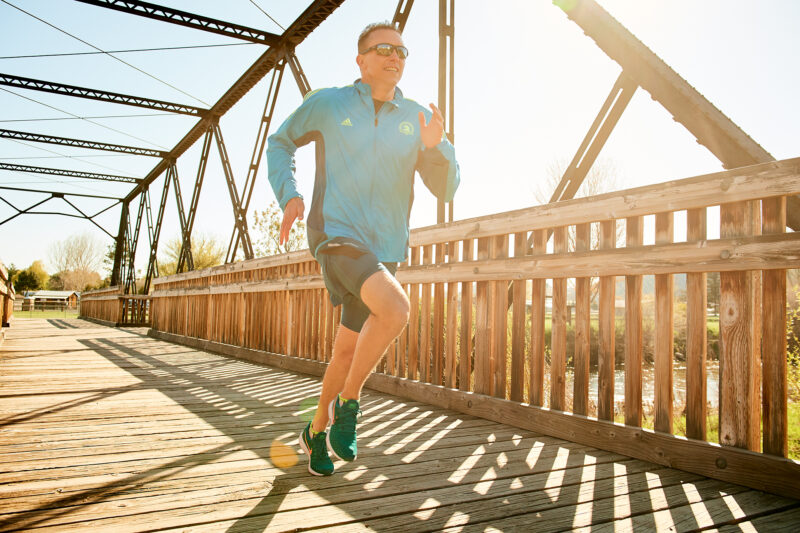
Running is a popular hobby and form of exercise here in Central Oregon and, while it is a great way to move your body, it also carries the risk of injury. Runners are especially susceptible to knee, foot, and ankle injuries. Below are tips on staying healthy and pain-free while running.
WEAR THE RIGHT SHOES
Something as simple as wearing the right shoe can improve performance and, most importantly, prevent you from developing certain running-related injuries such as plantar fasciitis. The plantar fascia is the strong band of tissue in the arch of your foot that runs from your heel to toe and absorbs strains and stress placed on the foot. Plantar fasciitis occurs when that supporting tissue becomes irritated and inflamed.
Finding the right shoe for running can be an overwhelming endeavor. There are hundreds of options to choose from and not every shoe is created equal. Neither is every foot. Your specific foot type and running style will determine the shoe that will keep your feet the happiest in the long run.
Your running shoes should be replaced regularly as they start to show structural damage after about 120 miles. Replace your shoes every six months or 500 miles, whichever comes first, so they don’t become a risk factor. This will help you avoid foot pain as your shoes begin to wear down and lose support.
WARM UP AND COOL DOWN
A five-minute warm up followed by stretching exercises is essential for injury prevention before going on a run. Important muscle groups to focus on include the quadriceps, hamstrings, calf muscles, and ankle muscles. Proper stretching before and after your run can help prevent injuries such as hamstring strains, ankle sprains, and shin splints.
GRADUALLY INCREASE DISTANCE
It’s important to pace yourself and gradually increase your running distance to avoid any stress fractures. Those with the highest risk of injury are novice runners with limited or no running experience, so it is best to start out with a mix of walking and running. Increasing your distance by no more than 10% each week can be helpful to avoid an overuse injury by doing too much too soon.
CROSS-TRAIN TO BUILD MUSCLE
To help protect your legs from the strain of running and prevent fewer injuries, build up strength by doing a variety of different exercises and workouts. Strength training helps to reduce excessive loading to the same muscles or work the same muscles in different ways. Squats, swimming, cycling, and lifting are some good examples. Yoga is also a beneficial way to improve your flexibility and stamina. Building muscle is essential to supporting the surrounding bones, tendons, and ligaments to avoid a running injury.
DON’T FORGET TO REST
It’s important to listen to your body for some key warning signals: soreness, aches, or lingering pain. If you feel even a slight discomfort while running, take a break to avoid any overuse injuries.
Incorporating rest days into your running regimen, staying hydrated, and eating nutritious foods are all essential to staying healthy while running.
COMMON INJURIES FROM RUNNING
Achilles Tendinitis:
Achilles tendinitis is a common condition that occurs when the large tendon that runs down the back of your lower leg, the Achilles tendon, becomes irritated and inflamed. Tendons, unlike bone, can’t repair themselves. After tendons are torn, they create a “scar-like” attempt to repair themselves, and that tissue does not have the same properties as the original tendon in terms of strength and elasticity.
Iliotibial Band Syndrome:
The iliotibial (IT) band is the thick band of tissue and muscles that run on the outside of your leg between the knee and hip. IT Band Syndrome occurs when the IT band becomes inflamed and irritated from overuse and causes sharp pain on the outside of the knee and sometimes hip.
Plantar Fasciitis:
Plantar fasciitis is the most common cause of foot pain, radiating from the bottom of the heel throughout the foot. This occurs when that supporting tissue becomes irritated and inflamed.
Shin Splints:
Shin splints is the pain along the inner edge of the shinbone (tibia). It typically develops after physical activity, especially running, and is most common if you are just starting a fitness program.
Stress Fractures:
Stress fractures are one of the most common sports injuries, especially in recreational runners. A stress fracture is an overuse injury that occurs when muscles become fatigued and are unable to absorb shock and protect the bones as they usually do. When stress is placed on fatigued muscles, eventually the overload of stress is transferred to the bone, causing a tiny crack or stress fracture. A stress fracture is a common overuse injury that occurs in the weight-bearing bones of the lower leg and foot.
Runner’s Knee:
Patellofemoral pain, or runner’s knee, is an irritation of the cartilage on the back of the patella (kneecap) that causes pain in one or both knees. This type of knee pain can develop because of overuse. It is a common knee injury in athletes such as long-distance runners that participate in high-impact sports, but it can occur in non-athletes as well. Patellofemoral pain can be caused by abnormal tracking of the kneecap. This abnormality may cause increased pressure at the back of the patella and irritate soft tissues.
If you are experiencing any lingering pain or discomfort, then it may be time to visit one of our sports medicine doctors for treatment.
The Center’s Dr. Katya Urch, and long time athlete, Colleen from FootZone Bend, host a webinar to discuss how the body changes as we get older which can increase the chance of injury and side-line us from doing the things we love. From running to cycling to walking, there are several activities that many of us would like to continue enjoying for a very long time, and knowing how to care for our bodies in every stage of life will help us do just that.
If you’re looking for more tips and information on living a healthy and pain free life, join our monthly newsletter. Link to sign up is below.





